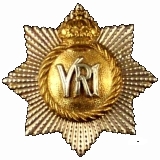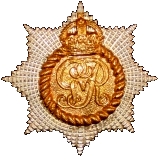
The Royal Canadian Regiment and
The First World War - 1914-1919
The Battle of Monchy-le-Preux
By: Major W.J. Home, M.C., The R.C.R.
The Connecting File, Volume XIV, No. 4; October 1935
After months of trench warfare, during which time nothing of a very serious or exciting nature took place, The R.C.R., an Infantry unit of the 3rd Canadian Division, moved out of the line and was sent from the Arras sector south to the Amiens sector, where the Regiment took part in the advance of the Canadian Corps and had a very much easier time than was expected by all ranks.
After the battle of Amiens, the Regiment was relieved by Imperials and entrained at Boyes for the North once more. After a train trip of a day's duration, besides several days of marching, the unit arrived at the "Y" Camp (which is one and a half miles W. S. W. of Arras and directly west of Dainville) with other units of the Brigade.
For two days the Battalion rested in this camp waiting for another battle in which they would again take an active part. During this rest period a great deal of re-organizing, drilling, cleaning up, etc., was done.
On the night of the 25th-26th of August [1918], the unit was ordered to move to trenches at a point one mile E. S. E. of Arras, and remain there until further orders. This was very successfully carried out, and the companies of the Battalion were resting in old trenches and dug-outs by 2345 hours. At 0200 hours the 26th Aug. a conference was called at Battalion Headquarters, for company and specialist commanders, which lasted until 0400 hours. During this period all preliminary arrangements were carried out, e.g., issuing of rations, bombs, water, etc. The Company Commanders, immediately after receiving their orders, reported back to their companies and held a conference of their platoon commanders, passing on to them the information received from the Battalion Commander. At this conference nothing very definite could be given out as all the information the Battalion Commander had was that we were to move from our present trenches at 0530 hours the 26th, and eventually, with other units of our Bde., make an attack on the enemy, "leap-frogging" or passing through the 8th Canadian Infantry Brigade, who were to start the initial attack at 0530 hours.
At 0530 hours, according to schedule, the Regiment moved off from its position, getting into artillery formation in case of emergency, although up to this time very little artillery fire had been encountered. The Artillery and Machine Guns laid down a heavy barrage fire, and the initial attack was soon in progress.
All this time the unit was moving forward, and at 0630 hours we began to "run into" ours and the enemy wounded and prisoners, and apparently everything was going well and the attack on the German first line was successful. At 0700 hours the Company had orders from Battalion Headquarters to assemble at a certain place on "Telegraph Hill," get under cover and await further orders, and for Company Commanders to proceed at once to Battalion Headquarters, which would be in that locality, and there attend a conference where final instructions as to the part we would take in the attack would be given out.
At this conference instructions were issued that as soon as the 8th Canadian Infantry Brigade had attained its objective - Monchy-Le-Preux - the Battalion was to move forward, "leap-frog" these battalions, make a "left-form" and capture the Bois du Sarto The R. C. R. was to be the right unit of the Brigade and of the Division, joining up with the 2nd Canadian Division on the Arras Cambrai road. The formation to be adopted in the Battalion in the attack, was three companies, "A", "B" and "C", in the firing line and "D" Coy. in Battalion reserve. During this conference the Companies were under continuous shelling, although not of a very heavy nature, but, as the Battalion was in the open, some casualties were suffered.
At 0900 hours word was received through Brigade that the 8th Canadian Infantry Brigade had captured its objective and that the Battalion was to be ready to start the advance immediately. However, we were kept in this position unti11100 hours before receiving the order to advance.
On leaving this position of assembly the Battalion moved off in companies in artillery formation, that is, with platoons at about 50 yards distance and 50 yards interval. However, on getting to within a half mile of Monchy it was found, owing to heavy shelling, that companies would have to further extend to platoons in artillery formation. This was carried out.
As the advance continued the shelling became more intense, and on reaching the village of Monchy a heavy barrage "was on" which it was necessary to pass through. Here, very many casualties were suffered owing to congestion, as it was at this point that the unit had to form on the Eastern side of Monchy. The Battalion passed through the 8th Brigade who had "dug in," and who apparently had not had a very hard time.
On reaching the Eastern side of Monchy the unit came upon more open ground and found the enemy ready to give us a battle. As soon as the enemy saw us they opened up M. G. and heavy rifle fire which temporarily held up the advance. The orders given out for the attack were, "C" Coy. right, "A" Coy. centre and "B" left; "B" Coy. connecting up with the P. P. C. L. I. on their left. Eventually "A" and "B" Coys. were successful in moving forward, under the impression that "C" Coy. was doing likewise. However, "C" Coy. was held up, its Company Commander dangerously wounded, and was unsuccessful in moving forward to sufficient distance to be of assistance to the other two Companies.
On coming under M. G. and rifle fire, sections extended to five paces between men and continued to advance, pushing the enemy back, inflicting casualties but suffering a great number themselves. At about 1300 hours the attack was held up yet some distance from the objective, and" A" Coy. found its right flank in the air. After holding on to the ground for an hour, it was found necessary to retire to a trench fifty yards in rear. This was successfully carried out. A long message was then sent to Battalion Headquarters explaining the situation, casualties, flanks, etc. In sending out a runner it was impossible to ascertain where Battalion Headquarters was; however, this was found by runner and message delivered.
At about 1400 hours, it was noticed that small parties of the enemy were moving forward on the R. flank. The Company consequently got ready to meet any attack, and had what men were left facing both ways in the trench as the Coy. was in a bad position, knowing that it could be attacked from the front and right rear. A further message was therefore sent to Battalion Headquarters pointing out the direction of the enemy's advance and the danger of our position. At dusk "D" Coy. which was in reserve, came up to the threatened flank, found the enemy advancing in strength, drove him back and established touch with the other two companies.
REMARKS
1. Conferences
At all the conferences held previous to the actual attack, only very indefinite information was given out.
2. Congestion.
(a) On reaching "Telegraph Hill" the Companies assembled here taking what cover was possible, but were "bunched" too much, and here several casualties were suffered.
(b) On reaching Monchy it was necessary to make a "left form." This caused a great deal of congestion, and the principle of changing direction once the attack had begun was contrary to Regulations.
3. Co-operation and Communication
(a) Very little co-operation between Coys.; with the consequences that "A" and "B" Coys. were ignorant of the fact that "C" Coy. was held up.
(b) There was no method of signal communication with Battalion Headquarters, and Coys. in front line were never sure where Headquarters was; although, through good work of runners these Headquarters were always found.
(c) Apparently no co-operation between our R. flank and L. flank of 2nd Division; this causing a big gap which nearly proved disastrous.
4. Delay in putting attack scheme into execution. At 0900 hours word was received from our Brigade Headquarters that the 8th Brigade had attained its objective. We were nevertheless kept at position of assembly until 1100 hours before continuing. the attack; this delay allowing enemy to get his Artillery, M.G.s, etc., into position and prepare for the second phase of attack, which, owing to delay, caused loss of impetus to attack.
Pro Patria
- The O'Leary Collection; Medals of The Royal Canadian Regiment.
- Researching Canadian Soldiers of the First World War
- Researching The Royal Canadian Regiment
- The RCR in the First World War
- Badges of The RCR
- The Senior Subaltern
- The Minute Book (blog)
- Rogue Papers
- Tactical Primers
- The Regimental Library
- Battle Honours
- Perpetuation of the CEF
- A Miscellany
- Quotes
- The Frontenac Times
- Site Map

![]() The RCR in the Great War
The RCR in the Great War
![]() War Diary
War Diary
![]() Battle Honours
Battle Honours
![]() Battle Bars and The RCR
Battle Bars and The RCR
![]() The RCR Battle Bar Ledger (pdf)
The RCR Battle Bar Ledger (pdf)
![]() Honours and Awards
Honours and Awards
![]() Roll of Honour
Roll of Honour
![]() Prisoners of War
Prisoners of War
![]() Cemetery List
Cemetery List
![]() Cemetery Map
Cemetery Map
![]() Courts Martial
Courts Martial
![]() Officers
Officers
![]() RSMs of The RCR (1914-1919)
RSMs of The RCR (1914-1919)
![]() NCOs and Soldiers
NCOs and Soldiers
![]() An Officer's Diary (1914-1918)
An Officer's Diary (1914-1918)
![]() Recollections of a Nonagenerian (R. England) (1916-1919)
Recollections of a Nonagenerian (R. England) (1916-1919)
![]() On to Bermuda (1914-15)
On to Bermuda (1914-15)
![]() England and France 1915-1916 (Hayes; 1931)
England and France 1915-1916 (Hayes; 1931)
![]() Overseas with The Royals (1915)
Overseas with The Royals (1915)
![]() Regimental History Pamphlet (1917)
Regimental History Pamphlet (1917)
![]() Amiens (1918)
Amiens (1918)
![]() Cambrai (1918)
Cambrai (1918)
![]() Monchy-le-Preux (1918)
Monchy-le-Preux (1918)
![]() Under-aged Soldiers in The RCR
Under-aged Soldiers in The RCR
![]() Not All Were Volunteers; The RCR and the Military Service Act
Not All Were Volunteers; The RCR and the Military Service Act
![]() Sentenced to Death by Court Martial
Sentenced to Death by Court Martial
![]() The 7th Trench Mortar Battery
The 7th Trench Mortar Battery
![]() A Regimental Goat
A Regimental Goat
![]() Regiment and Family, Bermuda 1914-15
Regiment and Family, Bermuda 1914-15
![]() "March the Guilty Bastard In"
"March the Guilty Bastard In"
![]() Surrendered as Stowaway
Surrendered as Stowaway
![]() Re-Visiting the Great War Roll of Honour for The RCR
Re-Visiting the Great War Roll of Honour for The RCR
![]() Canadian Corps Trench Standing Orders (1916)
Canadian Corps Trench Standing Orders (1916)

